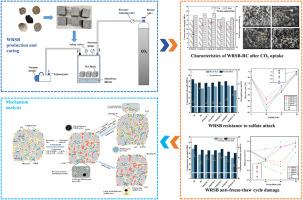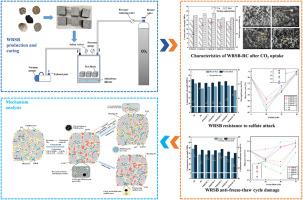废稻秸秆生物炭再生混凝土:固碳、耐久性和微观结构
IF 10
1区 环境科学与生态学
Q1 ENGINEERING, ENVIRONMENTAL
引用次数: 0
摘要
在再生混凝土中添加生物炭被认为是一种提高固碳效率的有效方法。本研究介绍了一种可持续低碳的绿色建筑材料,该材料用废秸秆生物炭(WRSB)代替RC中的部分水泥,并进行CO2固化。XRD和FTIR表明,适量的生物炭能促进CO2的吸收,加速水化过程。具体来说,按重量计添加5%的生物炭(WRSB-RC5),每千克混凝土的固碳能力为24.66克,抗压强度高达37.74 MPa。此外,由于炭化产物在生物炭和再生骨料(RA)孔隙中的快速积累,减缓了SO42-对水化产物的侵蚀速率,WRSB-RC5的抗硫酸盐系数高达90.7%。此外,碳化产物减少了可入水的毛细孔的体积,导致冻融强度损失率仅为8.68%。在反应初期,生物炭储存额外的水分,吸附CO2,而在反应后期,生物炭释放水分,加速内部水化反应,生成更多的碳酸化产物,显著增强固碳能力和耐久性。因此,WRSB与矿物碳化相结合可以作为一种环保的建筑材料,提高RC的性能,促进建筑垃圾的利用,增强固碳能力。本文章由计算机程序翻译,如有差异,请以英文原文为准。


Waste rice straw biochar recycled concrete: Carbon sequestration, durability and microstructure
Adding biochar to recycled concrete (RC) is considered an effective method to enhance carbon sequestration efficiency. This study introduces a sustainable and low-carbon green building material that replaces a portion of cement with waste rice straw biochar (WRSB) in RC and undergoes CO2 curing. XRD and FTIR indicate that an appropriate amount of biochar can promote CO2 absorption and accelerate the hydration process. Specifically, adding 5 % biochar by weight (WRSB-RC5) results in a carbon sequestration capacity of 24.66 g per kilogram of concrete and a compressive strength of up to 37.74 MPa. Furthermore, due to the rapid accumulation of carbonation products in the pores of biochar and recycled aggregate (RA), the rate of SO42− attack on hydration products is mitigated, and the sulfate resistance coefficient of WRSB-RC5 reaches as high as 90.7 %. Additionally, the carbonation products reduce the total volume of capillary pores accessible to water, resulting in a freeze-thaw strength loss rate of only 8.68 %. In the early reaction stage, biochar stores additional moisture and adsorbs CO2, while in the later stage, it releases moisture to accelerate the internal hydration reaction and generate more carbonation products, significantly enhancing carbon sequestration and durability. Therefore, the combination of WRSB and mineral carbonation can serve as an environmentally friendly building material to improve the performance of RC, promote the utilization of construction waste, and enhance carbon sequestration.
求助全文
通过发布文献求助,成功后即可免费获取论文全文。
去求助
来源期刊

Journal of Cleaner Production
环境科学-工程:环境
CiteScore
20.40
自引率
9.00%
发文量
4720
审稿时长
111 days
期刊介绍:
The Journal of Cleaner Production is an international, transdisciplinary journal that addresses and discusses theoretical and practical Cleaner Production, Environmental, and Sustainability issues. It aims to help societies become more sustainable by focusing on the concept of 'Cleaner Production', which aims at preventing waste production and increasing efficiencies in energy, water, resources, and human capital use. The journal serves as a platform for corporations, governments, education institutions, regions, and societies to engage in discussions and research related to Cleaner Production, environmental, and sustainability practices.
 求助内容:
求助内容: 应助结果提醒方式:
应助结果提醒方式:


